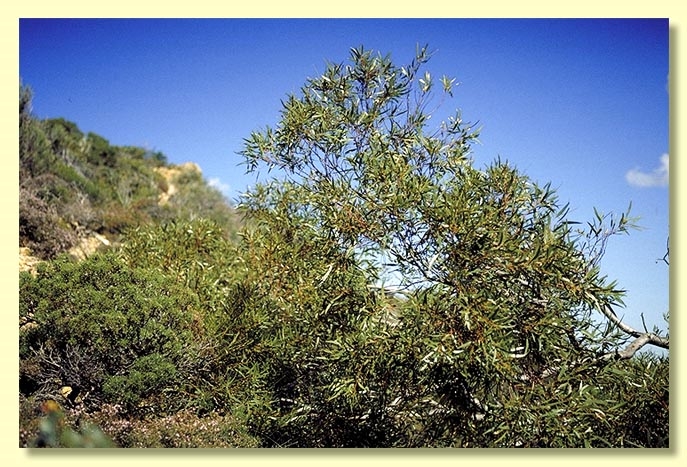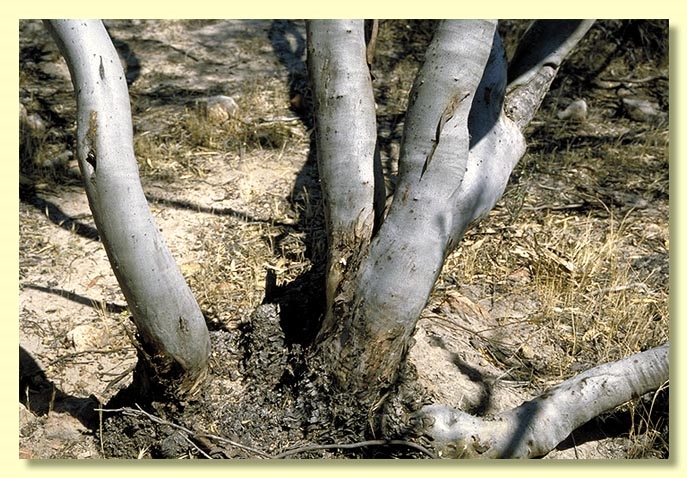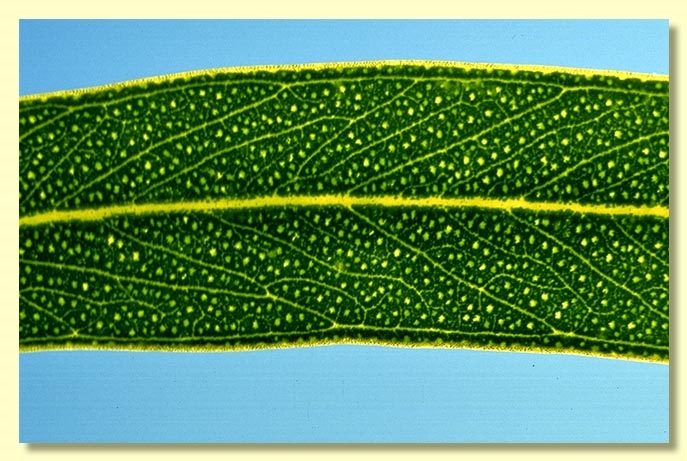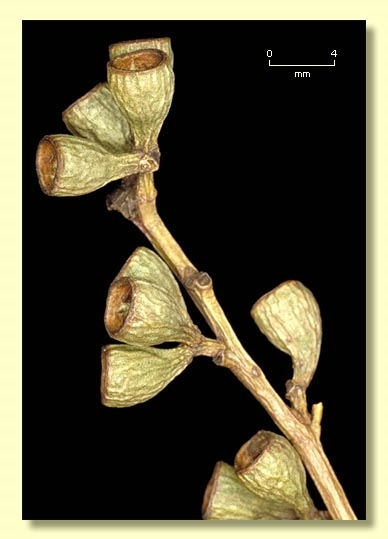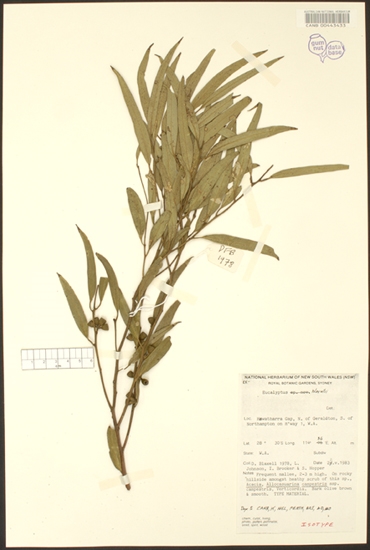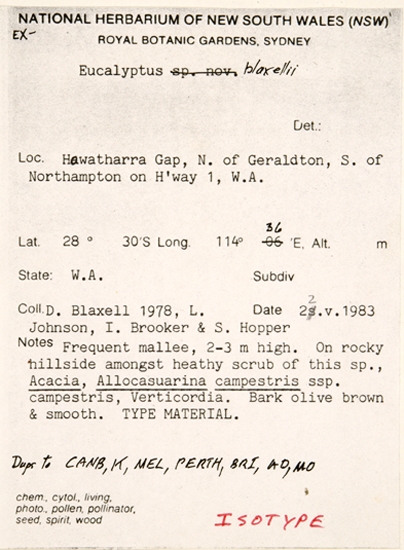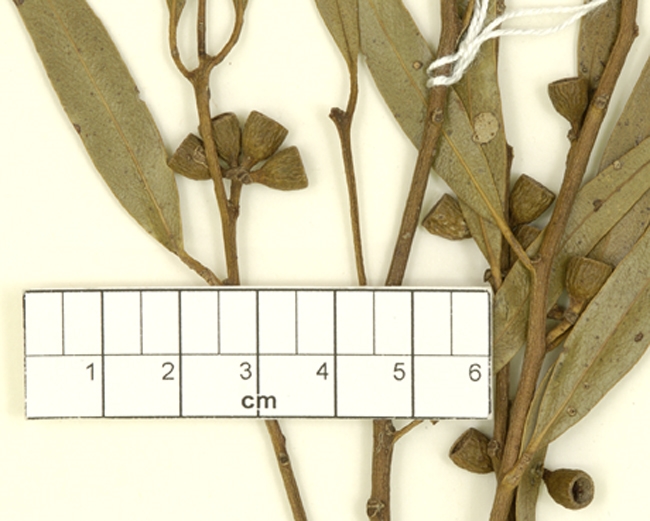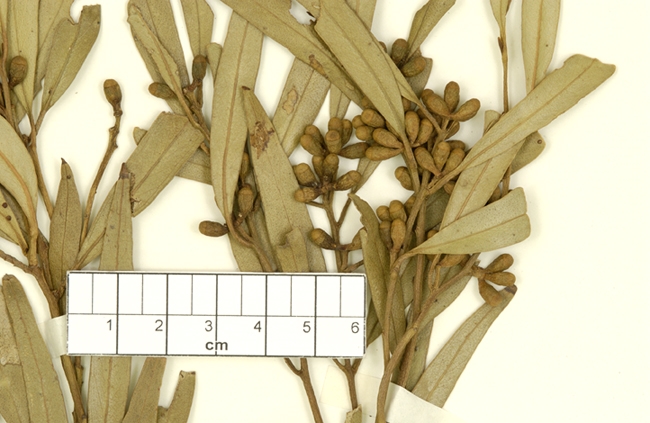Eucalyptus | Symphyomyrtus | Bisectae | Glandulosae | Loxophlebae
Euclid - Online edition
Eucalyptus blaxellii
Bark smooth, grey over bronze, yellow-green or coppery, rarely with a very short stocking of brown fibrous rough bark.
Branchlets with oil glands in the pith mainly near the nodes, maybe quite sparse in the internodes.
Juvenile growth (coppice or field seedlings to 50 cm): stems square to rounded in cross-section; juvenile leaves always petiolate, alternate, linear, often curved, 7–10.5 cm long, 0.4–0.7 cm wide, green.
Adult leaves alternate, petioles 0.5–1.5 cm long; blade linear to narrowly lanceolate, 6–10 cm long, 0.5–1 cm wide, base tapering to petiole, margin entire, apex acute, concolorous, glossy, green, side-veins acute, reticulation sparse, intramarginal vein close to margin, oil glands numerous, island.
Inflorescence axillary unbranched, peduncles 0.2–0.8 cm long, buds 7 per umbel, shortly and stoutly pedicellate (pedicels 0.2–0.3 cm long). Mature buds obovoid (0.4–0.8 cm long, 0.25–0.5 cm wide), scar present, operculum rounded or broadly conical, stamens inflexed and their filaments geniculate, all fertile, anthers cuboid to wedge-shaped, versatile, sub-basifixed, dehiscing by longitudinal slits, style long and straight, the base narrowed and inserted in a pit in ovary roof, stigma blunt to rounded, locules 3 or 4, the placentae each with 4 vertical rows of ovules. Flowers white.
Fruit pedicellate (pedicels 0.1–0.4 cm long), cupular to obconical, 0.4–0.6 cm long, 0.4–0.6 cm wide, disc descending, valves 3 or 4, enclosed or near rim level.
Seeds brown, 0.7–1.5 mm long, ovoid or flattened-ovoid, dorsal surface shallowly reticulate, hilum ventral.
Cultivated seedlings (measured at node 10): cotyledons Y-shaped (bisected); stems rounded or square in cross-section; leaves always petiolate, opposite for 4 or 5 nodes then alternate, narrowly lanceolate to lanceolate, 9–12.5 cm long, 1–2.2 cm wide, grey-green, dull at lower nodes, later leaves becoming green and slightly glossy.
Flowering has been recorded in May, July, September and October.
A small mallee endemic to Western Australia, from north of Geraldton in the Moresby Range, in stony creek flats and stony rises. The bark is smooth and the adult leaves glossy green.
Eucalyptus blaxellii belongs to Eucalyptus subgenus Symphyomyrtus section Bisectae subsection Glandulosae because the cotyledons are bisected, buds have an operculum scar and the branchlets have oil glands in the pith. Within this subsection E. blaxellii belongs to a small subgroup of four species, series Loxophlebae, further characterised by having buds with fully inflexed stamens with the staminal filaments geniculate or strongly elbowed and a style that tapers basally, sparsely reticulate glossy green adult leaves and small obconical fruit. The four species are E. loxophleba (four subspecies), E. blaxellii, E. articulata and from north-east of Meekatharra E. semota.
E. blaxellii is distinguished from the widespread E. loxophleba (York Gum) by its smooth-barked mallee habit and linear green juvenile leaves. It occurs within the geographic range of E. loxophleba subsp. loxophleba and west of the range of E. loxophleba subsp. supralaevis, both of which are much more widespread in the Wheatbelt and further to the east; both are rough-trunked trees usually on topographically lower sites than E. blaxellii and have glaucous very broad juvenile leaves. E. loxophleba subsp. gratiae and subsp. lissophloia are smooth-barked and occur much further to the south and east of the distribution of E. blaxellii and should not be confused with it.
The intramarginal vein of E. blaxellii is close to the leaf edge, whereas in the other species of the series the vein is well removed from the edge. E. blaxellii has the style base articulated within the ovary roof, a character it shares with E. articulata, a desert species from north-east of Kalgoorlie, but the latter has larger leaves, buds and fruits and has leaf venation similar to York Gum.
The northernmost species in the group, E. semota, is restricted to two sites, Mary Mia and Neds Corner, north-east of Meekatharra, and differs in having a scrappy mallee/tree habit, some rough bark and lanceolate green to grey-green juvenile leaves. It too has an articulate style-base.
Eucalyptus blaxellii is listed as "Vulnerable" under the Australian Government Environment Protection and Biodiversity Conservation Act 1999 (EPBC Act). Further information may be found at this web address: http://www.environment.gov.au/cgi-bin/sprat/public/sprat.pl

